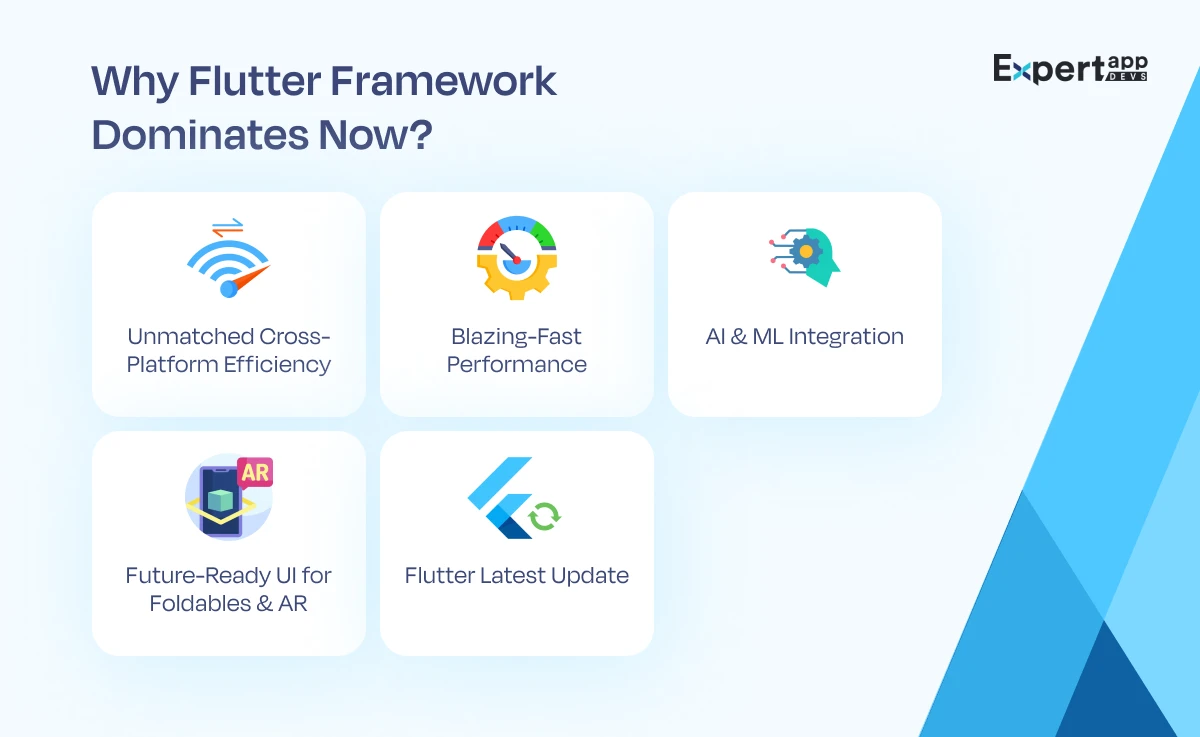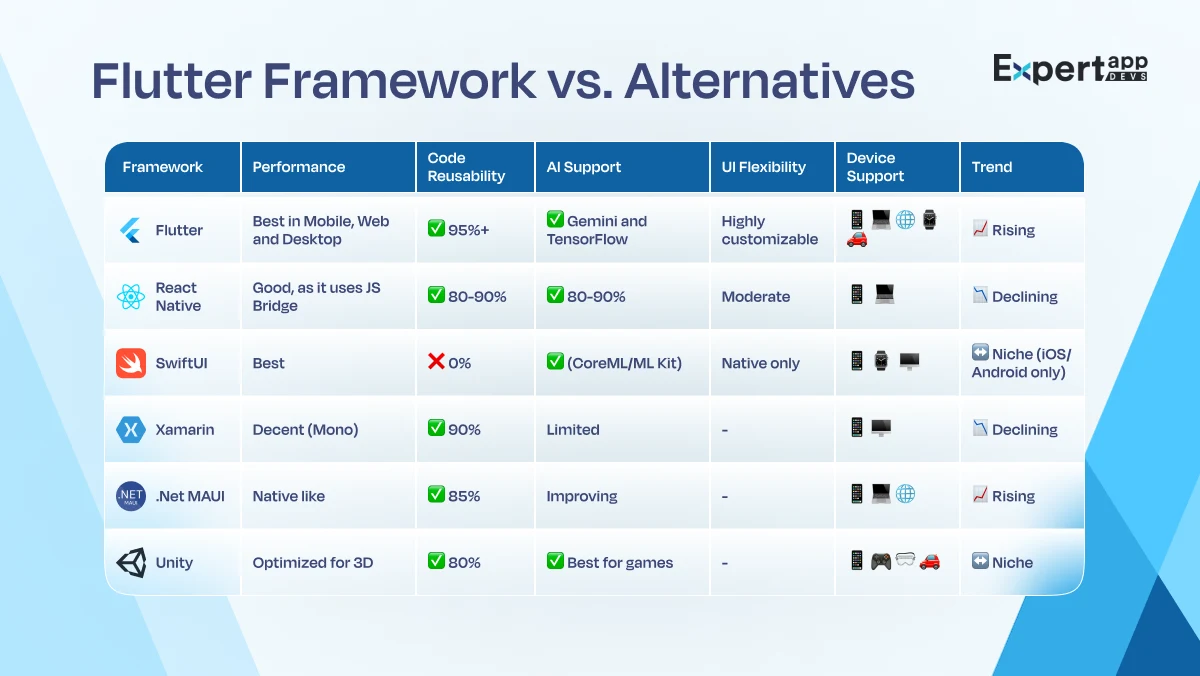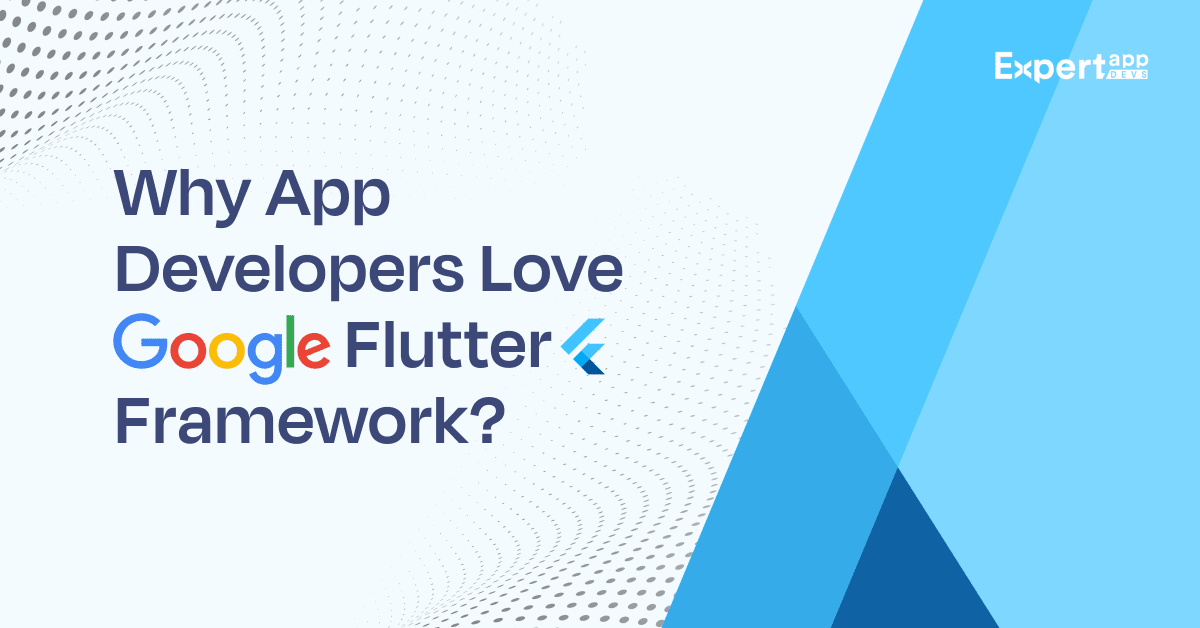Why App Developers Love Google’s Flutter Framework?
By 2025, over 50% of your mobile apps will be built using cross-platform frameworks like Flutter, indicating a major shift in the mobile app landscape. Should you be surprised? No! In fact, if you take a look at some of the apps around you, like Google Pay, My Garage for BMW and Xianyu Alibaba, they are all developed using the Flutter framework.
Flutter is not just another trendy new tool, but one of the best frameworks to build fast and consistent applications. You can use a single codebase to develop iOS, Android and web applications with this framework.
But what makes it developers' favourite framework? It can easily adapt to the latest technological evolutions like foldable screens, AI integrations and embedded applications for IoT devices. Basically, Flutter can keep pace with your evolving tech needs and help you build reliable solutions.
In this guide, we will look at all the reasons developers love Google’s Flutter framework and why this love is getting stronger.
What is Flutter Framework?
Flutter is the open-source UI toolkit designed to help developers create high-performance and visually aesthetic applications. You can use a single UI and codebase to build applications for multiple platforms and operating systems.
So, what is the real magic of the Flutter framework? You need to write the code and develop UI once and let Flutter replicate it across wherever it is deployed. You can save a lot of your time and resources without compromising quality.
Here are all the reasons the Flutter framework stands out!
- Single codebase with multiple platforms: You can build the app code once and run it across mobile, desktop and other platforms
- Natively compiled: You can build apps using Flutter to deliver smooth and fast apps as they can be compiled into the machine code
- Custom Expressive UI: Using pre-designed widgets and flexible layouts, you can create beautiful and consistent interfaces
- Tech-driven apps: Flutter can easily integrate with smart displays, wearables and in-car infotainment systems to deliver exceptional solutions
With Flutter, you don’t just build mobile apps; you can create cross-platform and seamless digital experiences.
Why Flutter Framework Dominates Now?
Is it just the hype that is fueling Flutter’s rapidly increasing popularity? No, it is more than just hype. Flutter offers some exceptional advantages to your business app, such as a fast development cycle and a growing ecosystem. Here are all the reasons Flutter is dominating the stage.

#1. Unmatched Cross-Platform Efficiency
Do you know Flutter framework’s biggest superpower? It can handle everything effortlessly, from mobile and web to desktop and embedded platforms by building a single codebase. Your developers don’t need to write separate code for the platforms, juggle their maintenance or rewrite the features to make it platform-specific.
As a result, it fosters faster development, quicker bug fixes and consistent user experience for your business application. With Flutter, you will note that developers can cut down their costs by 50% or more. This is especially true when you are a startup working on a tight budget and wanting to launch apps faster.
It can be a win for enterprises too in case you are managing complex projects across platforms. Flutter’s goes beyond traditional platforms like phones and desktops, allowing you to reach your users on their wearable and smartwatches. In fact, Flutter for automotive OS can also help you deliver apps for infotainment systems and in-car displays. With such flexibility and future-ready features, Flutter enables you to build apps for the futuristic customers without reinventing the wheel.
#2. Blazing-Fast Performance
Speed matters in the digital landscape, as it helps deliver a consistent and smooth user experience across devices. Without speed, you will kill your app and lose your audience base. Flutter delivers on the speed and performance promise. With its remarkable architecture and constant evolution, you can get guaranteed performance.
Unlike the other frameworks, Flutter doesn’t depend on JavaScript bridge to connect with the platform-specific components. Instead, Flutter can directly compile into the ARM code, which reduces your overheads and delays. It can also streamline the animations within your application.
Flutter 4.0 has unveiled some solid features, including the new Impeller rendering engine, making performance core to your application. It can improve your app’s performance by 20%, offering fast frame rendering and excellent graphics support.
So, whether you are building a complex UI for your application or a high-performing solution, Flutter gives you the desired tools to drive speed.
#3. AI & ML Integration
AI isn’t just a bonus for your application anymore, it is a necessity. Adding smart assistants to your app, offering personalized recommendations, and delivering important insights to your users is a great way to delight them.
Flutter makes it easy for you to meet the expectations of your users. With an in-built support for AI and ML tools, you can easily integrate the technology in your application.
TensorFlow Lite, an integral tool, allows you to integrate the on-device AI features into your Flutter applications. From image recognition to speech processing, Flutter can manage all your requirements with the highest performance and security-first solutions.
Moreover, the Gemini AI SDK by Google is backed by Flutter, which makes it easier for you to add relevant AI features. You can incorporate the advanced Chatbots, generative AI functionality and predictive UIs with this integration.
Basically, Flutter allows you to embrace AI without making you reinvent the wheel or go through hassles.
#4. Future-Ready UI for Foldables & AR
Devices are continuously evolving, which has led to changing user expectations. Flutter can ensure you keep pace with this curve. Whether you want to build an app for the traditional phone or for foldable devices like Samsung Galaxy Z Fold 6/Pixel Fold 2, Flutter makes it happen.
Using the framework’s adaptive layouts, you can ensure that the designs are responsive and fit into the numerous sizes and orientations.
Flutter framework offers you an in-built support for dynamic UI scaling and flexible design patterns, which makes developers offer a seamless experience. This is because the transition from phone to tablet is seamless, where your developers need not rethink the UI.
Flutter has also stepped into the world of AR with the help of ARKit and ARCore. As a result, your developers can build interactive and immersive AR features using a single Flutter codebase.
With such diverse interface solutions, ranging from AR devices to futuristic phones, Flutter gives developers the ability to build their next reliable project.
#5. Flutter Latest Update
Flutter framework has extended its capabilities in the wake of new advancements to offer your developers tools to build high-performing applications. With Flutter 4.0, you get performance upgrades that can help you build reliable versions.
The new and advanced version comes with an Impeller rendering engine that makes rendering 20% faster and delivers a smooth UI experience. It also extends support to WebAssembly (WASM) which enables web application development to deliver native-like performance. With WASM, you can enhance compilation that allows apps to run at near-native browser speed.
Quantum UI engine allows your Flutter apps to adjust the themes to meet the operating system and device settings. With this feature, your developers can provide a cohesive and personalized interface to work effortlessly across platforms.
Lastly, state management using Riverpod 3.0 can help developers use the robust framework to manage applications. Moreover, the Flame game engine provides comprehensive tools to your game developers.
Who’s Using Flutter Framework?
Flutter is growing popular globally, with some of the tech giants picking up the framework to power their users' digital experiences. Here are some of the top brands and how they have used the Flutter framework to build their solutions.
#1. Tesla
This company has embraced the Flutter framework to build the in-car infotainment system, thus pushing out sleek and dynamic updates. With the framework, they have been able to deliver delightful user experiences for behind-the-wheel users.
#2. Meta
They have used Flutter to incorporate AR-powered social features. With Meta’s new features, you will gain insight into the reliability and robustness of the Flutter framework to handle complex and immersive interfaces.
#3. Nike
They have developed a smart fitness app that goes beyond tracking steps. With AI-backed coaching that they built using the Flutter framework, the app extends a seamless experience across devices.
Flutter helps companies manage innovation at scale with its speed, flexibility and performance. The way these popular brands have created thriving applications with Flutter goes to say how this framework is going to lead digital interactions in the future.
Flutter Framework vs. Alternatives
By choosing the right framework, you can lead your application to success. This is especially true when you aim for speed and scalability while developing applications.

Flutter is known for offering the best performance and flexible development that extends your reach across platforms. React Native has traction but is continuously losing steam. It also comes with performance limitations and limited AI tools.
Swift and Kotlin offer platform-specific and native development, while Unity is best for gaming applications. It may not be suited for standard UI applications.
The Future of Flutter Framework
Flutter is a fast-evolving framework and goes beyond helping you build mobile applications. With emerging technologies reshaping your users’ digital interactions with different devices, Flutter is all set to expand its reach.
Today, the framework is ready to enter newer territories like spatial computing, Web3 and no-code development.
#1. Spatial Computing
You may have noticed that there has been an increase in the number of immersive platforms like Apple Vision Pro and Meta Quest. No wonder Flutter is being used to build AR and VR interfaces. Using this framework, your developers can build 3D spatial experiences with the toolkit they use for mobile, web and desktop. In fact, you can even use it to deliver extended reality solutions.
#2. Flutter + Blockchain
Web3 and decentralized apps are becoming mainstream, and you can use Flutter to create diverse solutions. These include crypto wallets, NFT platforms and DeFi applications. Owing to the fast rendering and single codebase, you can build secure and high-performance applications using Blockchain.
#3. No-code Flutter with Project IDX
Using a combination of Flutter and Project IDX, you can use no-code and low-code tools to build reliable applications. Your Flutterflow developers can use the visuals to build apps and tap into the full potential of the framework to accelerate prototyping.
Conclusion
Flutter isn’t another trend that will fade away with time. It is the standard framework to build modern and scalable applications that help you in delivering future-proof development.
For startups, Flutter can reduce the costs and time while for enterprises, it can deliver consistent performance across platforms. With support for futuristic and advanced technologies like AI, IoT and next-gen devices, it is one of the smartest choices for app development.
If you want to build a future-ready digital product, you should hire Flutter developers now. Expert App Devs has a dedicated app development team that can help build unique and reliable solutions. Connect with our team with your requirements now.
 Jignen Pandya
Jignen Pandya




